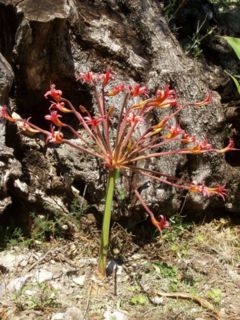Brunsvigia: Difference between revisions
No edit summary |
No edit summary |
||
| Line 11: | Line 11: | ||
The bulbs must be thoroughly rested from the time the leaves fade until the scape appears. Brunsvigias are hard to flower. They require rich, sandy soil, plenty of heat and sunlight. When growing, give water and liquid manure freely. They propagate by offsets. For fuller instructions, see Amaryllis. | The bulbs must be thoroughly rested from the time the leaves fade until the scape appears. Brunsvigias are hard to flower. They require rich, sandy soil, plenty of heat and sunlight. When growing, give water and liquid manure freely. They propagate by offsets. For fuller instructions, see Amaryllis. | ||
B. falcata, Ker-Ammocharis falcata.—B. magnifica, Lind. Fls. 20-25 in a cluster; corolla short; the segm. white, with medium stripe of red or purplish red: Lvs. 1-2 ft. long, 3-3½ in. wide, recumbent.—Thought by Baker to be Crinum Forbesianum or near that species. | |||
}} | }} | ||
Revision as of 23:20, 13 February 2010
| Brunsvigia subsp. var. | ||||||||||||||||||||||||||||||||||||||||||||||||||||||||
|---|---|---|---|---|---|---|---|---|---|---|---|---|---|---|---|---|---|---|---|---|---|---|---|---|---|---|---|---|---|---|---|---|---|---|---|---|---|---|---|---|---|---|---|---|---|---|---|---|---|---|---|---|---|---|---|---|

|
|
| ||||||||||||||||||||||||||||||||||||||||||||||||||||||
| ||||||||||||||||||||||||||||||||||||||||||||||||||||||||
| Standard Cyclopedia of Horticulture |
|---|
|
Brunsvigia (after the Duke of Brunswick). Amaryllidaceae. Tender summer- or autumn-flowering bulbs. Umbels of large numerous brick-red fls.; corolla funnelformed, 6-parted, deciduous, its segms. nearly equal, recurved at the tip.—Species 9. S. Afr. The bulbs must be thoroughly rested from the time the leaves fade until the scape appears. Brunsvigias are hard to flower. They require rich, sandy soil, plenty of heat and sunlight. When growing, give water and liquid manure freely. They propagate by offsets. For fuller instructions, see Amaryllis. B. falcata, Ker-Ammocharis falcata.—B. magnifica, Lind. Fls. 20-25 in a cluster; corolla short; the segm. white, with medium stripe of red or purplish red: Lvs. 1-2 ft. long, 3-3½ in. wide, recumbent.—Thought by Baker to be Crinum Forbesianum or near that species.
|
| Brunsvigia {{{status}}} Fossil range: {{{fossil_range}}}
| ||||||||||||||||||||||||||||||||||||||||||||||||||||||||||||||||||
|---|---|---|---|---|---|---|---|---|---|---|---|---|---|---|---|---|---|---|---|---|---|---|---|---|---|---|---|---|---|---|---|---|---|---|---|---|---|---|---|---|---|---|---|---|---|---|---|---|---|---|---|---|---|---|---|---|---|---|---|---|---|---|---|---|---|---|
 Brunsvigia josephinae | ||||||||||||||||||||||||||||||||||||||||||||||||||||||||||||||||||
| Plant Info | ||||||||||||||||||||||||||||||||||||||||||||||||||||||||||||||||||
| ||||||||||||||||||||||||||||||||||||||||||||||||||||||||||||||||||
| Scientific classification | ||||||||||||||||||||||||||||||||||||||||||||||||||||||||||||||||||
| ||||||||||||||||||||||||||||||||||||||||||||||||||||||||||||||||||
| [[{{{diversity_link}}}|Diversity]] | ||||||||||||||||||||||||||||||||||||||||||||||||||||||||||||||||||
| {{{diversity}}} | ||||||||||||||||||||||||||||||||||||||||||||||||||||||||||||||||||
| Binomial name | ||||||||||||||||||||||||||||||||||||||||||||||||||||||||||||||||||
| {{{binomial}}} | ||||||||||||||||||||||||||||||||||||||||||||||||||||||||||||||||||
| Trinomial name | ||||||||||||||||||||||||||||||||||||||||||||||||||||||||||||||||||
| {{{trinomial}}} | ||||||||||||||||||||||||||||||||||||||||||||||||||||||||||||||||||
| Type Species | ||||||||||||||||||||||||||||||||||||||||||||||||||||||||||||||||||
| {{{type_species}}} | ||||||||||||||||||||||||||||||||||||||||||||||||||||||||||||||||||
| {{{subdivision_ranks}}} | ||||||||||||||||||||||||||||||||||||||||||||||||||||||||||||||||||
| [[Image:{{{range_map}}}|{{{range_map_width}}}|]] | ||||||||||||||||||||||||||||||||||||||||||||||||||||||||||||||||||
| Synonyms | ||||||||||||||||||||||||||||||||||||||||||||||||||||||||||||||||||
| {{{synonyms}}} |
Brunsvigia is a flowering plant genus in the family Amaryllidaceae. It contains about 20 species native to South Africa.
Brunsvigia are tender bulbs, winter-growing and summer-dormant, generally flowering in early autumn. Their flowers are brilliant scarlet, pink, or red. Species include:
- Brunsvigia appendiculata
- Brunsvigia bosmaniae
- Brunsvigia comptonii
- Brunsvigia grandiflora
- Brunsvigia gregaria
- Brunsvigia herrei
- Brunsvigia josephinae
- Brunsvigia litoralis
- Brunsvigia marginata
- Brunsvigia natalensis
- Brunsvigia orientalis
- Brunsvigia pulchra
- Brunsvigia radula
- Brunsvigia radulosa
- Brunsvigia striata
- Brunsvigia undulata
External links
References
- R.A. Dyer, 1950: A review of the genus Brunsvigia. Plant Life 6: 63-83
- R.A. Dyer, 1951: A review of the genus Brunsvigia. Plant Life 7: 44-64
- C.A. Smith, 1966: Common names of South African plants. Memoirs of the Botanical Survey of South Africa No. 35. TheGovernment Printer, Pretoria
- R.S. Adamson, T.A. Salter (eds.), 1950: Flora of the Cape Peninsula. Juta, Cape Town and Johannesburg
- J. Manning, P. Goldblatt, 2000: Wild flowers of the fairest Cape. Red Roof Design in association with the Nationalotanical Institute, Cape Town
- E.G. Rice, R.H. Compton, 1950: Wild flowers of the Cape of Good Hope. The Botanical Society of SA, Cape Town
- A. Pauw, S. Johnson, 1999: Table Mountain: a natural history. Fernwood Press
- G.D. Duncan, 2000: Grow bulbs. Kirstenbosch Gardening Series, National Botanical Institute, Cape Town
- G.D. Duncan, 2002: Grow nerines. Kirstenbosch Gardening Series, National Botanical Institute, Cape Town